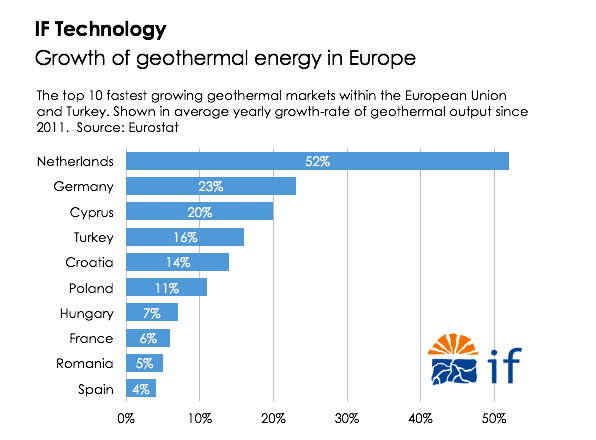The rapid development of geothermal energy in the Netherlands
Geothermal energy utilisation has seen a tremendous growth in The Netherlands over recent years and it is today the market having grown the most.
Geothermal energy has been developing rapidly in the Netherlands and in this guest piece by Niek Willemsen of IF Technology, the reasons for this growth are described.
There are several reasons for the extraordinary growth of geothermal energy in the Netherlands. One of the biggest is the excellent regulatory framework implemented by the Dutch government over the past years. There are some lessons to be learned here that might help other countries boost the development of their geothermal sector as well
One of the main challenges faced by geothermal developers is the combination of geological uncertainty with high upfront costs and the resulting difficulty in acquiring adequate financing. The Dutch government has developed policy instruments that tackle these barriers which has facilitated the rapid development of geothermal energy in The Netherlands. The most important of these instruments are listed below
NLOG public subsurface data
The NLOG stands for Netherlands Oil and Gas portal. This is a public database that holds all subsurface data (e.g. well logs and geophysical surveys) gathered under a mining permit. This includes data from the oil and gas industry, mining and scientific research. The Dutch mining law obliges all parties operating under a mining permit to deliver the acquired data to the governmental organization TNO. This data will then be made public five years after acquisition.
This system is of vital importance to the geothermal industry as it all but eliminates the need for exploration drilling. Based purely on the available data in The Netherlands it is possible to get a 90% certainty estimate (P90) of the power output of a projected well pair. This high degree of certainty means up to 70% bank financing is possible without the need for additional exploration activities. This significantly reduces the up-front costs and risks for geothermal project developers.
State owned risk mitigation fund
The Dutch government set up a fund to mitigate the geological risks within geothermal projects. This risk mitigation fund pays out 85% of well costs in case the thermal power output is less than the previously mentioned P90 estimate. The fee is 7% of the costs covered. A recent evaluation shows the fund has even made a small net profit. However, it is not expected that commercial insurance companies are willing to cover these geological risks in the near future. Based on this expectation the Dutch government will keep the fund open for at least 5 more years.
Feed-in premium for renewable heat
The Netherlands has a feed in premium for renewable heat to stimulate the transition from a fossil based energy system to a renewable energy system. This program is called SDE+ and it pays out the difference between the costs of fossil energy and renewable energy. There is a set amount of subsidy each year and the cheapest forms of renewable energy get subsidized first. So far, geothermal heat is one of the cheapest forms of renewable energy per MWh in The Netherlands. As such geothermal heat has scored a large amount of SDE+ subsidy: in 2016 total the amount committed for geothermal was 3,9 billion euro for a total of 100 million MWh of heat.
The result
The result of these measures is that the Dutch geothermal market is now the fastest growing in Europe by a large margin as shown below. The Dutch geothermal sector has seen a steady 50% annual growth-rate in output over the past 4 years. One of the main reasons is the sound regulatory framework set up since 2011. This could serve as an inspiration for other countries looking to boost their geothermal energy production.

Article provided by Niek Willemsen, IF Technology/ The Netherlands
The picture above shows the company Floricultura heemskerk, see http://www.floricultura.nl/